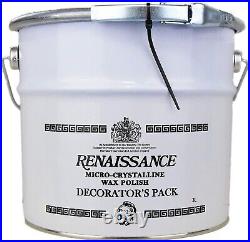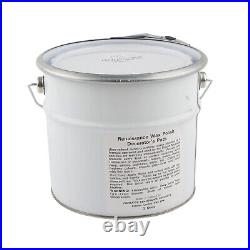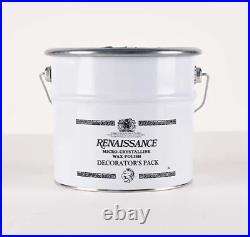



MA Polishing and finishing Supplies Ltd. Renaissance Micro Crystalline Wax Polish 3 Litre Can – For Wood, Metals & Leathe. RENAISSANCE WAX POLISH CAN BE USED ON VIRTUALLY ANY SURFACE RANGING FROM PAPER TO STONE. A soft wax polish for all parts of your items. Shines while leaving a protective film. Resists liquid spillage DOES NOT SHOW FINGERPRINTS. Developed by The British Museum as an acid-free preserving wax. Ideal for sealing Patinas. Prevents the oxidisation & rusting of metals. Produces an invisible protective layer on many materials from wood and ceramics. Appy to wooden and other delicate surfaces, it will leave them polished and gleaming. This highly-effective micro-crystalline wax polish from Renaissance wax is perfect for your antiques and other valuables. Applied to wooden and other delicate surfaces, it leaves them polished and gleaming, and in addition, it removes accumulated grime that previous polishes have left behind. With protective properties, it forms an invisible barrier that resists unsightly fingerprints as well as the potentially damaging effects of smears and spillages. Renaissance Wax polish was originally formulated in the British Museum research laboratories in the early 1950? S, in response to a discussion amongst museum technicians at an international conference on fine-art conservation. In accelerated ageing tests, the British Museum scientist found that all current commercial waxes based on the usual natural waxes (beeswax and carnauba wax) contained acids which, in time, could spoil original finishes on national historic collections of furniture. He rejected them all and investigated the new so-called? Or microcrystalline waxes being refined out of crude oil. With their distinct characteristics depending on their geographical origins, the new? Waxes could be accurately blended to meet the needs of many industries, from cosmetics and pharmaceuticals to heavy engineering. Thus, the waxes combined Nature? S best qualities with the advantages of modern technology. The blend which emerged from that research was? For long-term protection of all classes of museum exhibits. At last, museum technicians and others caring for important collections could use wax polish that neither caused future conservation problems nor detracted from the intrinsic values of their treasures. Commercial production and distribution of the polish was ultimately undertaken in 1968 by the London-based company Picreator Enterprises Ltd. Under its trade name? The product was quickly accepted in the international museum world and has become a universally respected standard conservation material? Probably the most widely specified because of its almost unlimited uses. What makes Renaissance wax so different? It has a crystalline structure much finer than totally natural waxes, a property that confers a highly efficient moisture resistance. Countless statues and monuments in city streets are now protected by Renaissance wax from weathering corrosion. Arms and armour, steel and kitchen equipment of brass and copper in historic house museums, are kept bright and corrosion-free. When thinly applied and rubbed out to full lustre, the wax film is (and remains) glass-clear, with no discoloration either of the wax or the underlying surface. Renaissance wax is free from acids (pH neutral) and will not damage even sensitive materials. For example, photographs for exhibition or of historic value are waxed to protect the image from the natural acidity of hand or environmental pollutants. The wax does not stain or darken even white paper. On furniture or wood carvings the wax delicately enhances grain or? It protects existing finishes such as french polish and can also be applied directly to sanded, unfinished hardwoods without need of sealers. Waxing is the last process in hand-made furniture and in the creation of wood, stone or metal sculptures. But it is the first aspect to be appreciated by hand and eye. The clarity and lustre of Renaissance wax makes an instant visual appeal. The silk-smooth touch of the matured wax film gives added pleasure, compared to the? Of fingers leaving trails across the softer beeswax polishes. No matter how often the wax is used there is no loss of clarity, so that fine surface detail is never obscured. Repeated use of the wax deepens the lustre, reflecting more light from surfaces and making them more? Picreator receives hundreds of enquiries from around the world asking if Renaissance wax is suitable for a specific surface or project. Invariably the answer is? The wax is, for example, replacing the preservative oiling of arms and armour in museums. The wax film is hard and dry and does not, like oil, remain sticky and attract atmospheric acidity. Exhibits are more comfortable to handle. Renaissance wax is used by customers in the following ways: To protect metals such as silver, brass and copper from tarnishing, on collections of all types of metals (old coins, locks and keys, arms and armour both original and replica), on both the wood and metal surfaces of vintage cars and musical instruments, on bronze sculptures inside the home and outside exposed to the elements, on marble and granite worktops to prevent staining and on smooth leather items. These are just some of the applications the wax has been used on. In the unlikely event, if the item is faulty/damaged or the wrong item was sent, we will cover the return cost. Thank You for shopping with us and we hope to see you soon!

